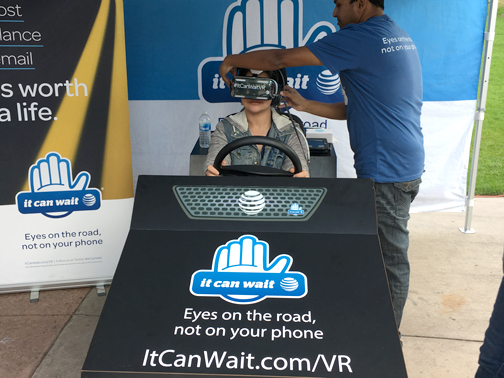
Glendale Community College student Sofiya Ghazaryan described the AT&T sponsored VR experience as “intense.” The experience was part of the communication company’s “It Can Wait” campaign.
By Charly SHELTON
According to a new survey by AT&T this year, 70% of drivers confess to using their smartphones while driving. Not just texting, but emailing, using social media, taking pictures and more. Even a momentary check of the phone can pull a driver’s awareness from the road, putting their life and the lives of those around them at risk. To combat this, AT&T launched its “It Can Wait” campaign to remind drivers that nothing is so important that it can’t wait.
“In 2010, our CEO Randall Stevenson thought [the campaign] would be a great idea because everybody has these phones and we want people to be responsible with them. In 2013 we started traveling the country and going to high schools, colleges, military bases – pretty much any place – and spreading the ‘It Can Wait’ message to everyone,” said Christopher Johnson, AT&T tour spokesperson for the “It Can Wait” campaign.
The campaign has travelled the country, hitting all 50 states with its interactive experience to show firsthand the dangers of distracted driving. As part of the campaign, AT&T developed a virtual reality video in which a driver becomes increasingly more distracted by his phone and encounters several near-miss accidents before finally being hit and killed while answering a text. This VR video is shown to one person at a time while they are sitting in a mini cardboard car and wearing a Samsung VR headset at the “It Can Wait” event. Upon exiting the experience, guests are invited to take the “It Can Wait” pledge to not use their phone while driving. To date, 12,731,196 pledges have been taken, over 10 million of which came from the “It Can Wait” travelling event.
On Nov. 1, the experience came to Glendale Community College to give the students a chance to see the VR experience and take the pledge.
“I don’t know what to expect because I haven’t asked my friends, but I think it’s [involves] speed … like you’ll feel you’re driving and actually in the car and it’s going really fast,” said GCC student Sofiya Ghazaryan just before entering the VR vehicle.
Ghazaryan said that she does not often use her phone while driving, usually keeping it in the back of the car, but she will when she feels there is a need. After exiting the VR experience, she was a bit shaken.
“It was intense. You could see the effect of texting and driving,” Ghazaryan said.
The 70% statistic from this year, now three years into the campaign, only reinforces Johnson’s desire to get the message out to the public, hoping to lower that statistic in the future.
“That was an AT&T survey done this year and 70% of people admit to using their smartphone behind the wheel, which is even more of a reason why we need to keep spreading this message to remind everyone that no post, no text, no selfie, no email is worth your life or somebody else’s life,” Johnson said.
The VR video is available as a free app on the App Store for iPhone and on Google Play for Android, or on YouTube in both regular video and VR, for users to experience it at home and share with other drivers to help further the message that “It Can Wait.”
For more information, visit itcanwait.com and scan the QR code attached to this story to see the video on YouTube.
